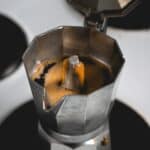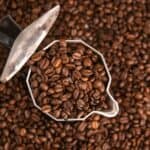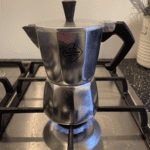The Best Grind Size For Moka Pot Revealed!
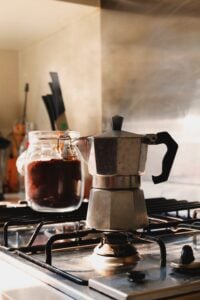
The Moka pot has become a mainstay in coffee loving households across the world, especially in Europe. This small but mighty device can brew strong, espresso-like coffee quickly and with no fuss.
However, dialing in the correct grind size can be a tricky task, especially for new Moka pot users. Grind size plays a major role in how your Moka pot coffee will taste, as well as its strength, the level of extraction and how quickly it brews.
So, let’s dive into the best grind size for Moka pot so you get the best results every single time.
The Best Grind Size for Moka Pot
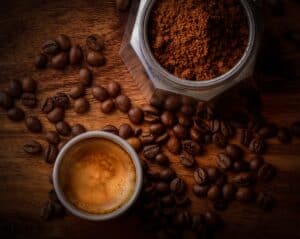
The best grind size for a Moka pot is a medium to fine grind. This is because a relatively fine grind is needed to extract coffee oils and flavor compounds rapidly due to high pressure steam build up. This should be slightly finer than a medium grind used for pour over coffee, but not as fine as an espresso grind.
Using the wrong grind size for your Moka pot can actually impact the taste and strength of your coffee quite a bit. Without getting too bogged down in the science, let’s take a brief look at what happens if you grind your coffee too coarsely or too finely for your Moka pot.
Grind size should be driven by the method of brewing you choose to use. This is because variables like flow rate, contact time and extraction rate all play into how much actual coffee you’ll produce, and how strong it will be.
The inner workings of grind size can be dealt with in another article, but effectively the more pressure and heat used in a coffee brewing method, the finer the grind size should be.
This is why we use a particularly fine grind for espresso, but even within this there can be wild variations on flavor, extraction and flow rate based on grind size.
Too Coarse Leads to Under Extraction
As far as the Moka pot is concerned, aiming for a medium to fine grind is the best way to go for people new to this brewing method.
It is definitely better to opt for a grind you think may be too coarse when starting out, than one that’s too fine.
This will give you weaker coffee, but more consistent results. From there it is easy to dial the grind size down to find your desired strength.
However, if you grind your coffee too coarsely, you’ll end up with under extracted coffee. This means that the hot water has not come into contact with enough of the coffee’s surface area, and not enough of the flavor compounds and oils have been extracted from the coffee.
This results in highly acidic, weak and sometimes sour coffee that is quite unpleasant to drink.
Too Fine Leads to Over Extraction
On the other end of the spectrum, using a fine grind more suited to espresso in your Moka pot will lead to over extraction.
Over extraction is actually more common than you might think across many different coffee brewing methods, and causes the coffee oils to be extracted too quickly.
This leads to bitter, burnt tasting coffee that can have a silty aftertaste and is also pretty nasty to drink.
Using a grind size that’s too fine could actually be quite dangerous.
Since the pre-punched holes in the Moka pot’s filter basket are designed to take medium to fine ground coffee, using a grind too fine could clog up these holes and create a build up of pressure that’s too high as the steam won’t flow up the central chamber freely.
In extreme cases this could cause a coffee explosion!
Therefore, using a grind size that sits between fine espresso grind and a medium pour over grind (leaning more towards medium than fine), would be my recommendation.
It’s better to start off slightly too coarse and dial it down finer with each brew than the other way round. After all, you’d rather have coffee that’s slightly weaker than you might like, rather than risk an exploding Moka pot!
What is a Moka Pot?
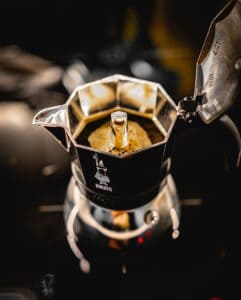
A Moka pot is a coffee brewing device that uses pressurized steam to make strong, espresso-like coffee. The first Moka pot was created back in 1933 by Italian designer Alfonso Bialetti, who then founded the company, Bialetti Industries.
Bialetti still remains the most popular brand of Moka pot to date, as their heritage and traditional, simplistic design is a classic cornerstone of Italian kitchens.
The Moka pot became so popular as it brewed strong coffee quickly and easily, without the need of a fancy or expensive commercial espresso machine.
Whilst Moka pot coffee is technically not the same as espresso (as it is not as strong and brews using less pressure), it is loosely comparable as both methods utilized pressurized steam to drive hot water through relatively fine coffee grounds.
For reference, a Moka pot will brew coffee at around 1.5 bar, whereas an espresso machine will typically use around 9 bar. This is a significant difference and goes to show why espresso shots come out a lot stronger than Moka pot coffee.
That being said, compared to other brewing methods like French press or pour over, a Moka pot does a pretty good job of brewing strong, bold tasting coffee.
How Does a Moka Pot Work?
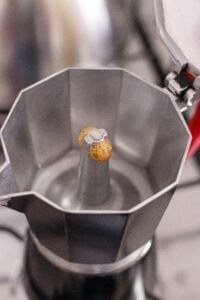
A Moka pot works by applying heat to the bottom of the device and heating up the lower water chamber, which then produces high pressure, boiling water. Then, as the pressure builds up, the steam generated rises through the compacted, medium to fine ground coffee beans, so the coffee oils and flavor compounds can be extracted.
This process continues until more and more liquid passes through the coffee grounds, which then rise up through the central chamber of the Moka pot as the pressure gradually builds up.
The fact that Moka pots are made using either steel or aluminum makes them great heat conductors, and therefore means they are able to brew coffee in no time at all.
Moka pots brew coffee more quickly than most other methods, so a finer grind is needed to extract the right amount of coffee.
Check out this article to discover how to make coffee in a Moka pot properly, step by step!
Why Grind Size Matters
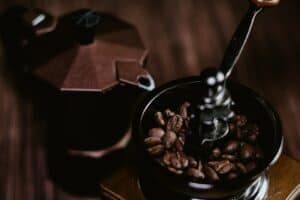
Grind size plays a more important role than you might think in how your coffee tastes. Every coffee brewing method requires a different grind size and in truth, there is no one size fits for each of these either.
The perfect grind size for a particular coffee brewing method may differ from one person to another, depending on how they like their coffee, the equipment they have available and their level of experience.
As a very rough rule of thumb, here is a list of coffee brewing methods with their corresponding grind sizes, from most fine to most coarse:
- Very Fine: Turkish Coffee Pot, Espresso
- Fine: Espresso, Aeropress
- Fine to Medium: Moka Pot
- Medium: Pour Over, Drip Machine
- Medium to Coarse: Chemex
- Coarse: French Press, Percolator
- Very Coarse: Cold Brew.
Other Variables to Consider When Using a Moka Pot
Grind size is a very important factor when brewing coffee in a Moka pot, but here are a few other things to consider.
Type of Coffee Used
Moka pots brew coffee quickly and under a lot of pressure compared to other methods. Therefore, you’ll want to use a coffee bean that brings out the best of this method, and doesn’t lose its natural flavor.
Therefore, a dark or medium roasted coffee with nutty, chocolate or caramel flavors would be my recommendation for use in a Moka pot.
Using a light roasted coffee with delicate floral or citrus flavors wouldn’t necessarily be the best idea, since these more subtle flavors will likely get lost in the boldness of the brew.
Brew Time
Brew time also plays an important role in determining how consistently your coffee is extracted for a particular brewing method.
You should aim for a steady flow rate when using a Moka pot, which is achieved by placing it on a medium stovetop heat and ensuring your coffee doesn’t spurt or splutter out of the central chamber into the coffee collection part of the pot.
The time required to brew coffee in a Moka pot will be anywhere between 2 and 4 minutes depending on the size of your pot. However, the key is to find an amount of heat, time and flow rate that gives you a steady flow of coffee rather than a small dribble or aggressive splutter once the coffee starts to brew.
Heat
The amount of heat applied to your Moka pot will have a big influence on how quickly your coffee is extracted, as this will impact the level of pressure built up in the lower chamber.
Start off your stove top flame or induction hob ring on a medium to low heat, so the pressure builds up gradually. You should aim for around a 2 minute brew in a smaller, single serve (3 Oz) Moka pot, and around a 4 minute brew for a large Moka pot (around 6 Oz).
If your coffee isn’t brewing quickly enough, then you can always turn up the heat slightly to get things moving.
However, if your Moka pot is starting to gurgle and splutter aggressively, you can remove it from the heat altogether or run the base under a cold tap to cool it off.
Heat control is arguably the most important and sensitive variable in Moka pot coffee brewing.
Serving Size
Fortunately for coffee lovers, the serving size needed to make great Moka pot coffee is already predetermined by the manufacturer.
The filter basket is designed to hold the perfect amount of coffee for a roughly 1:7 coffee to water ratio, which delivers a strong brew. So, simply fill up your basket with medium to finely ground coffee, level it off with a knife and away you go!
Moka Pot Preparation
Another important factor in ensuring you make great coffee in your humble Moka pot is in how you actually prepare the brewing device in the first place.
Adding boiling water to the lower chamber of your Moka pot is a good start, as it makes brew time and extraction faster and more consistent.
Also, using a tea towel to hold the base of your Moka pot before touching it will help you avoid any burnt fingers!
Make sure to screw the top of your Moka pot on tightly, and don’t tamp or press down on your coffee grounds or you could cause a big mess!
Use Filtered Water
Using filtered water in your Moka pot will help generate a cleaner tasting coffee, as well as reduce the risk of limescale build up in your kettle and Moka pot itself. Filtered water also takes the variables of water hardness out of the equation, giving you more consistent results wherever you’re brewing.
Summary
Overall, the best grind size for a Moka pot is a medium to fine grind, due to the amount of pressure needed to extract the coffee flavor compounds and oils from the beans themselves.
There is a lot of variation that goes into grind size, and every coffee brewing method has its own requirements.
As far as the Moka pot goes, aiming for a grind size that is slightly finer than that used for pour over, but not quite as fine as espresso will yield the best tasting coffee and the most consistent results.
Moka Pot Grind Size Frequently Asked Questions
Yes, using the finely ground coffee for espresso in a Moka pot is not a good idea. Not only will you end up with bitter, over extracted and sediment filled coffee, but you can also clog up your Moka pot’s filter basket and cause a coffee explosion!
Simply fill up your Moka pot’s filter basket to the top and that will give you the perfect coffee to water ratio for a small 3 Oz single serve brew.
Yes, Moka pot coffee is stronger than regular coffee brewed in a drip brew machine, pour over or French press. However, it is not as strong as espresso but has a similar strength to Aeropress.

